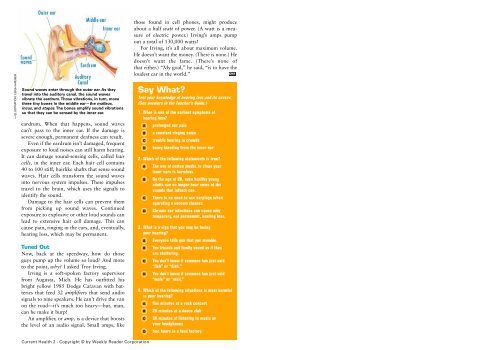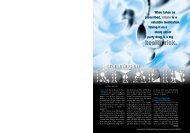Noise Alert
Noise Alert
Noise Alert
Create successful ePaper yourself
Turn your PDF publications into a flip-book with our unique Google optimized e-Paper software.
—ILLUSTRATION: LEIGH HAEGER<br />
Sound waves enter through the outer ear. As they<br />
travel into the auditory canal, the sound waves<br />
vibrate the eardrum. Those vibrations, in turn, move<br />
three tiny bones in the middle ear—the malleus,<br />
incus, and stapes. The bones amplify sound vibrations<br />
so that they can be sensed by the inner ear.<br />
eardrum. When that happens, sound waves<br />
can’t pass to the inner ear. If the damage is<br />
severe enough, permanent deafness can result.<br />
Even if the eardrum isn’t damaged, frequent<br />
exposure to loud noises can still harm hearing.<br />
It can damage sound-sensing cells, called hair<br />
cells, in the inner ear. Each hair cell contains<br />
40 to 100 stiff, hairlike shafts that sense sound<br />
waves. Hair cells transform the sound waves<br />
into nervous system impulses. These impulses<br />
travel to the brain, which uses the signals to<br />
identify the sound.<br />
Damage to the hair cells can prevent them<br />
from picking up sound waves. Continued<br />
exposure to explosive or other loud sounds can<br />
lead to extensive hair cell damage. This can<br />
cause pain, ringing in the ears, and, eventually,<br />
hearing loss, which may be permanent.<br />
Tuned Out<br />
Now, back at the speedway, how do those<br />
guys pump up the volume so loud? And more<br />
to the point, why? I asked Troy Irving.<br />
Irving is a soft-spoken factory supervisor<br />
from Augusta, Mich. He has outfitted his<br />
bright yellow 1985 Dodge Caravan with batteries<br />
that feed 32 amplifiers that send audio<br />
signals to nine speakers. He can’t drive the van<br />
on the road—it’s much too heavy—but, man,<br />
can he make it burp!<br />
An amplifier, or amp, is a device that boosts<br />
the level of an audio signal. Small amps, like<br />
those found in cell phones, might produce<br />
about a half watt of power. (A watt is a measure<br />
of electric power.) Irving’s amps pump<br />
out a total of 130,000 watts!<br />
For Irving, it’s all about maximum volume.<br />
He doesn’t want the money. (There is none.) He<br />
doesn’t want the fame. (There’s none of<br />
that either.) “My goal,” he said, “is to have the<br />
loudest car in the world.”<br />
Say What?<br />
Test your knowledge of hearing loss and its causes.<br />
(See answers in the Teacher’s Guide.)<br />
1. What is one of the earliest symptoms of<br />
hearing loss?<br />
A prolonged ear pain<br />
B a constant ringing noise<br />
C trouble hearing in crowds<br />
D heavy bleeding from the inner ear<br />
<br />
2. Which of the following statements is true?<br />
A The use of cotton swabs to clean your<br />
inner ears is harmless.<br />
B By the age of 20, even healthy young<br />
adults can no longer hear some of the<br />
sounds that infants can.<br />
C There is no need to use earplugs when<br />
operating a vacuum cleaner.<br />
D Chronic ear infections can cause only<br />
temporary, not permanent, hearing loss.<br />
3. What is a sign that you may be losing<br />
your hearing?<br />
A Everyone tells you that you mumble.<br />
B You friends and family sound as if they<br />
are stuttering.<br />
C You don’t know if someone has just said<br />
“fish” or “dish.”<br />
D You don’t know if someone has just said<br />
“male” or “mail.”<br />
4. Which of the following situations is most harmful<br />
to your hearing?<br />
A five minutes at a rock concert<br />
B 20 minutes at a dance club<br />
C 30 minutes of listening to music on<br />
your headphones<br />
D two hours in a loud factory<br />
<br />
Current Health 2 · Copyright © by Weekly Reader Corporation

















